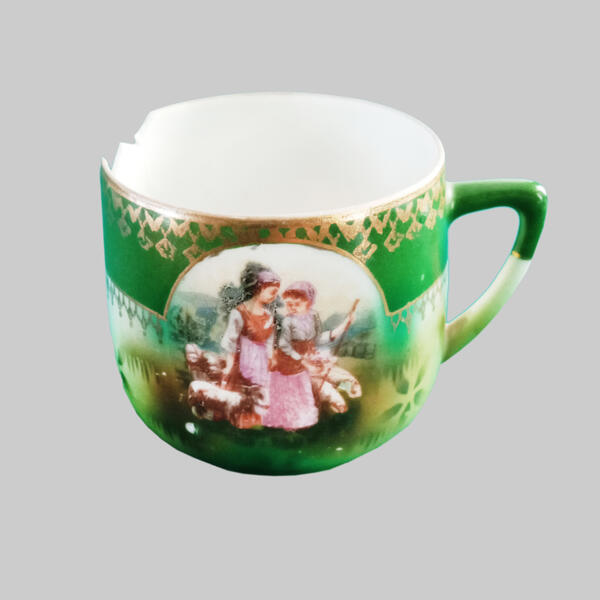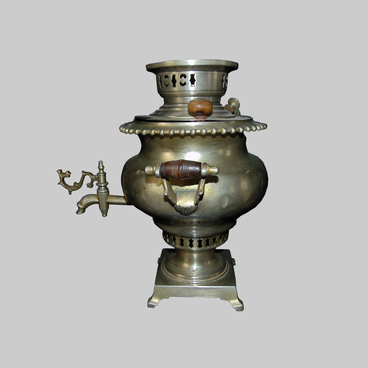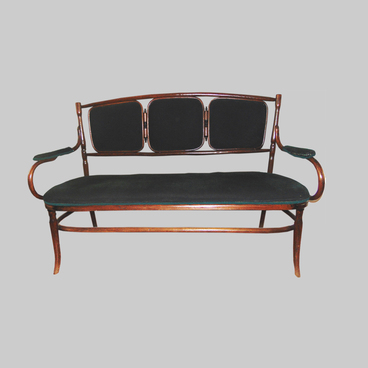Along with Gzhel toys, samovars, and Khokhloma decorations, Russian porcelain tableware is one of those things that still shape a generalized and perhaps even stereotypical idea of pre-revolutionary Russia. In many ways, such a reputation for Russian porcelain was created by the Partnership of Porcelain and Faience Manufacture of M.S. Kuznetsov, often rightly called the Porcelain Empire.
In the large sitting room on Michael Thonet’s coffee table there is a complete set made at one of the Partnership’s factories in the early 20th century. Similar to the rest of the items in the set, the tea cup’s outer surface is decorated in soft green shades; in the center of it there is a picture, typical for romantic pastoral painting of the 19th century, while the inner part of it is left untouched and immediately stands out in its white ceramic color. There was also a saucer in the set, along with the cup. Curiously enough, until the 1820s it was often used to cool some of the hot beverage from the cup, but later, this action was deemed inelegant and was gradually forbidden in secular etiquette. Later, a special indentation for the cup started appearing in the saucers, which helped secure their use as coasters.
Although porcelain and faience products of the Kuznetsov Partnership had played a very important role in the history of Russian decorative and applied art, it was only recently that they received a well-deserved appreciation and were honored the status of antiques. This fact can be explained in several different ways. On the one hand, Soviet art critics were rather reluctant to study Kuznetsov’s products: an overly flattering opinion of an art piece made in Imperial Russia may have led to grave career problems, as it could be regarded as endorsing the capitalist culture. On the other hand, the Partnership itself primarily focused on mass market, which often led to a decrease in both the quality of the porcelain itself and the quality of its decoration.
Nevertheless, Kuznetsov porcelain was a large international brand at the turn of the 20th century. In 1889 and 1890 the Partnership was awarded gold medals at several international exhibitions, and in 1903 in Reims and later in 1905 in Liege it was honored with the Grand Prix.
In the large sitting room on Michael Thonet’s coffee table there is a complete set made at one of the Partnership’s factories in the early 20th century. Similar to the rest of the items in the set, the tea cup’s outer surface is decorated in soft green shades; in the center of it there is a picture, typical for romantic pastoral painting of the 19th century, while the inner part of it is left untouched and immediately stands out in its white ceramic color. There was also a saucer in the set, along with the cup. Curiously enough, until the 1820s it was often used to cool some of the hot beverage from the cup, but later, this action was deemed inelegant and was gradually forbidden in secular etiquette. Later, a special indentation for the cup started appearing in the saucers, which helped secure their use as coasters.
Although porcelain and faience products of the Kuznetsov Partnership had played a very important role in the history of Russian decorative and applied art, it was only recently that they received a well-deserved appreciation and were honored the status of antiques. This fact can be explained in several different ways. On the one hand, Soviet art critics were rather reluctant to study Kuznetsov’s products: an overly flattering opinion of an art piece made in Imperial Russia may have led to grave career problems, as it could be regarded as endorsing the capitalist culture. On the other hand, the Partnership itself primarily focused on mass market, which often led to a decrease in both the quality of the porcelain itself and the quality of its decoration.
Nevertheless, Kuznetsov porcelain was a large international brand at the turn of the 20th century. In 1889 and 1890 the Partnership was awarded gold medals at several international exhibitions, and in 1903 in Reims and later in 1905 in Liege it was honored with the Grand Prix.



